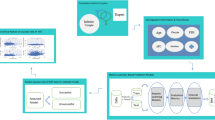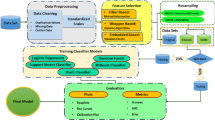Abstract
Purpose
This study aimed to evaluate the effectiveness of a random forest (RF) model in predicting clinical pregnancy outcomes from intrauterine insemination (IUI) and identifying significant factors affecting IUI pregnancy in a large Chinese population.
Methods
Results
A total of 11 variables, including eight from female (age, body mass index, duration of infertility, prior miscarriage, and spontaneous abortion), hormone levels (anti-Müllerian hormone, follicle-stimulating hormone, luteinizing hormone), and three from male (smoking, semen volume, and sperm concentration), were identified as the significant variables associated with IUI clinical pregnancy in our Chinese dataset. The RF-based prediction model presents an area under the receiver operating characteristic curve (AUC) of 0.716 (95% confidence interval, 0.6914–0.7406), an accuracy rate of 0.6081, a sensitivity rate of 0.7113, and a specificity rate of 0.505. Importance analysis indicated that semen volume was the most vital variable in predicting IUI clinical pregnancy.
Conclusions
The machine learning–based IUI clinical pregnancy prediction model showed a promising predictive efficacy that could provide a potent tool to guide selecting targeted infertile couples beneficial from IUI treatment, and also identify which parameters are most relevant in IUI clinical pregnancy.




Similar content being viewed by others
Data availability
The data that support the findings of this study are available from the corresponding author upon reasonable request.
References
Penzias A, Bendikson K, Falcone T, Hansen K, Hill M, **dal S, et al. Evidence-based treatments for couples with unexplained infertility: a guideline. Fertil Steril. 2020;113:305–22.
Nandi A, Raja G, White D, Tarek ET. Intrauterine insemination + controlled ovarian hyperstimulation versus in vitro fertilisation in unexplained infertility: a systematic review and meta-analysis. Arch Gynecol Obstet. 2022;305:805–24.
Bai F, Wang DY, Fan YJ, Qiu J, Wang L, Dai Y, et al. Assisted reproductive technology service availability, efficacy and safety in mainland China: 2016. Hum Reprod. 2020;35:446–52.
Kozar N, Kovač V, Reljič M. Can methods of artificial intelligence aid in optimizing patient selection in patients undergoing intrauterine inseminations? J Assist Reprod Genet. 2021;38:1665–73.
Garcia-Grau E, Oliveira M, Amengual MJ, Rodriguez-Sanchez E, Veraguas-Imbernon A, Costa L, et al. An algorithm to predict the lack of pregnancy after intrauterine insemination in infertile patients. J Clin Med. 2023;12:3225.
Zarinara A, Zeraati H, Kamali K, Mohammad K, Shahnazari P, Akhondi MM. Models predicting success of infertility treatment: a systematic review. J Reprod Infertil. 2016;17:68–81.
Leushuis E, van der Steeg JW, Steures P, Bossuyt PMM, Eijkemans MJC, van der Veen F, et al. Prediction models in reproductive medicine: a critical appraisal. Hum Reprod Update. 2009;15:537–52.
Khodabandelu S, Basirat Z, Khaleghi S, Khafri S, Montazery Kordy H, Golsorkhtabaramiri M. Develo** machine learning-based models to predict intrauterine insemination (IUI) success by address modeling challenges in imbalanced data and providing modification solutions for them. BMC Med Inform Decis Mak. 2022;22:228.
Steures P, van der Steeg JW, Mol BW, Eijkemans MJ, van der Veen F, Habbema JD, et al. Prediction of an ongoing pregnancy after intrauterine insemination. Fertil Steril. 2004;82:45–51.
Custers IM, Steures P, van der Steeg JW, van Dessel TJHM, Bernardus RE, Bourdrez P, et al. External validation of a prediction model for an ongoing pregnancy after intrauterine insemination. Fertil Steril. 2007;88:425–31.
Sidey-Gibbons JAM, Sidey-Gibbons CJ. Machine learning in medicine: a practical introduction. BMC Med Res Methodol. 2019;19:64.
Blank C, Wildeboer RR, DeCroo I, Tilleman K, Weyers B, de Sutter P, et al. Prediction of implantation after blastocyst transfer in in vitro fertilization: a machine-learning perspective. Fertil Steril. 2019;111:318–26.
Nesbit CB, Blanchette-Porter M, Esfandiari N. Ovulation induction and intrauterine insemination in women of advanced reproductive age: a systematic review of the literature. J Assist Reprod Genet. 2022;39:1445–91.
Kuru PM, Kokanali D, Kokanali K, Tasci Y. Effect of time intervals from the end of sperm collection to intrauterine insemination on the pregnancy rates in controlled ovarian hyperstimulation-intrauterine insemination cycles. J Gynecol Obstet Hum Reprod. 2018;47:561–4.
Vander BM, Wyns C. Fertility and infertility: definition and epidemiology. Clin Biochem. 2018;62:2–10.
Mehrjerd A, Rezaei H, Eslami S, Ratna MB, Khadem GN. Internal validation and comparison of predictive models to determine success rate of infertility treatments: a retrospective study of 2485 cycles. Sci Rep. 2022;12:7216.
Ranjbari S, Khatibi T, Vosough Dizaji A, Sajadi H, Totonchi M, Ghaffari F. CNFE-SE: a novel approach combining complex network-based feature engineering and stacked ensemble to predict the success of intrauterine insemination and ranking the features. BMC Med Inform Decis Mak. 2021;21:1.
Merviel P, Heraud MH, Grenier N, Lourdel E, Sanguinet P, Copin H. Predictive factors for pregnancy after intrauterine insemination (IUI): an analysis of 1038 cycles and a review of the literature. Fertil Steril. 2010;93:79–88.
Sakhel K, Abozaid T, Schwark S, Ashraf M, Abuzeid M. Semen parameters as determinants of success in 1662 cycles of intrauterine insemination after controlled ovarian hyperstimulation. Fertil Steril. 2005;84:S248–9.
Kulaksiz D, Toprak T, Tokat E, Yilmaz M, Ramazanoglu MA, Garayev A, et al. Sperm concentration and semen volume increase after smoking cessation in infertile men. Int J Impot Res. 2022;34:614–9.
Wessel JA, Danhof NA, van Eekelen R, Diamond MP, Legro RS, Peeraer K, et al. Ovarian stimulation strategies for intrauterine insemination in couples with unexplained infertility: a systematic review and individual participant data meta-analysis. Hum Reprod Update. 2022;28:733–46.
Xue X, Shi W, Zhou H, Tian L, Zhao Z, Zhou D, et al. Cumulative live birth rates according to maternal body mass index after first ovarian stimulation for in vitro fertilization: a single center analysis of 14,782 Patients. Front Endocrinol (Lausanne). 2020;11:149.
Qu P, Yan M, Zhao D, Wang D, Dang S, Shi W, et al. Association between pre-pregnancy body mass index and miscarriage in an assisted reproductive technology population: a 10-year cohort study. Front Endocrinol (Lausanne). 2021;12:646162.
Yavuz A, Demirci O, Sozen H, Uludogan M. Predictive factors influencing pregnancy rates after intrauterine insemination. Iran J Reprod Med. 2013;11:227–34.
Gindoff PR, Jewelewicz R. Reproductive potential in the older woman. Fertil Steril. 1986;46:989–1001.
Faddy MJ, Gosden RG, Gougeon A, Richardson SJ, Nelson JF. Accelerated disappearance of ovarian follicles in mid-life: implications for forecasting menopause. Hum Reprod. 1992;7:1342–6.
Attali E, Yogev Y. The impact of advanced maternal age on pregnancy outcome. Best Pract Res Clin Obstet Gynaecol. 2021;70:2–9.
Thijssen A, Creemers A, Van der Elst W, Creemers E, Vandormael E, Dhont N, et al. Predictive value of different covariates influencing pregnancy rate following intrauterine insemination with homologous semen: a prospective cohort study. Reprod Biomed Online. 2017;34:463–72.
Soria M, Pradillo G, García J, Ramón P, Castillo A, Jordana C, et al. Pregnancy predictors after intrauterine insemination: analysis of 3012 cycles in 1201 couples. J Reprod Infertil. 2012;13:158–66.
Jain A, Polotsky AJ, Rochester D, Berga SL, Loucks T, Zeitlian G, et al. Pulsatile luteinizing hormone amplitude and progesterone metabolite excretion are reduced in obese women. J Clin Endocrinol Metab. 2007;92:2468–73.
Regan L, Owen EJ, Jacobs HS. Hypersecretion of luteinising hormone, infertility, and miscarriage. Lancet. 1990;336:1141–4.
Iliodromiti S, Kelsey TW, Wu O, Anderson RA, Nelson SM. The predictive accuracy of anti-Müllerian hormone for live birth after assisted conception: a systematic review and meta-analysis of the literature. Hum Reprod Update. 2014;20:560–70.
Hansen KR, He ALW, Styer AK, Wild RA, Butts S, Engmann L, et al. Predictors of pregnancy and live-birth in couples with unexplained infertility after ovarian stimulation-intrauterine insemination. Fertil Steril. 2016;105:1575-1583.e2.
Vitale SG, Angioni S, Parry JP, Di Spiezio Sardo A, Haimovich S, Carugno J, et al. Efficacy of Hysteroscopy in Improving Fertility Outcomes in Women Undergoing Assisted Reproductive Technique: A Systematic Review and Meta-Analysis of Randomized Controlled Trials. Gynecol Obstet Invest. 2023;88:336–48.
Brodin T, Bergh T, Berglund L, Hadziosmanovic N, Holte J. High basal LH levels in combination with low basal FSH levels are associated with high success rates at assisted reproduction. Hum Reprod. 2009;24:2755–9.
Handelman GS, Kok HK, Chandra RV, Razavi AH, Lee MJ, Asadi H. eDoctor: machine learning and the future of medicine. J Intern Med. 2018;284:603–19.
Rahimian F, Salimi-Khorshidi G, Payberah AH, Tran J, Ayala Solares R, Raimondi F, et al. Predicting the risk of emergency admission with machine learning: development and validation using linked electronic health records .Sheikh A, editor. PLoS Med. 2018;15:e1002695.
Goldman RH, Batsis M, Petrozza JC, Souter I. Patient-specific predictions of outcome after gonadotropin ovulation induction/intrauterine insemination. Fertil Steril. 2014;101(1649–55):e1-2.
Ainsworth AJ, Barnard EP, Baumgarten SC, Weaver AL, Khan Z. Intrauterine insemination cycles: prediction of success and thresholds for poor prognosis and futile care. J Assist Reprod Genet. 2020;37:2435–42.
Camacho DM, Collins KM, Powers RK, Costello JC, Collins JJ. Next-generation machine learning for biological networks. Cell. 2018;173:1581–92.
Deo RC. Machine learning in medicine: will this time be different? Circulation. 2020;142:1521–3.
Liu L, Jiao Y, Li X, Ouyang Y, Shi D. Machine learning algorithms to predict early pregnancy loss after in vitro fertilization-embryo transfer with fetal heart rate as a strong predictor. Comput Methods Programs Biomed. 2020;196:105624.
Liu X, Chen Z, Ji Y. Construction of the machine learning-based live birth prediction models for the first in vitro fertilization pregnant women. BMC Pregnancy Childbirth. 2023;23:476.
Author information
Authors and Affiliations
Contributions
RH conceived and designed the research. WJZ provided statistical guidance. JLW analyzed the results and drafted the manuscript. TTL, LNC, and JLW performed the research and acquired the data. LNX, XYL, AHL, WJZ, RH, and JLW interpreted the data and modified the manuscript. All authors revised and approved the final version of the manuscript and agree to be accountable for all aspects of the work.
Corresponding authors
Ethics declarations
Ethics approval
This study has been approved by the Ethics Committee of the Sixth Affiliated Hospital of Sun Yat-Sen University (2019ZSLYEC-011S).
Consent to participate
All patients provided written informed consent.
Competing interests
The authors declare no competing interests.
Additional information
Publisher's Note
Springer Nature remains neutral with regard to jurisdictional claims in published maps and institutional affiliations.
Supplementary Information
Below is the link to the electronic supplementary material.
Rights and permissions
Springer Nature or its licensor (e.g. a society or other partner) holds exclusive rights to this article under a publishing agreement with the author(s) or other rightsholder(s); author self-archiving of the accepted manuscript version of this article is solely governed by the terms of such publishing agreement and applicable law.
About this article
Cite this article
Wu, J., Li, T., Xu, L. et al. Development of a machine learning–based prediction model for clinical pregnancy of intrauterine insemination in a large Chinese population. J Assist Reprod Genet (2024). https://doi.org/10.1007/s10815-024-03153-2
Received:
Accepted:
Published:
DOI: https://doi.org/10.1007/s10815-024-03153-2




